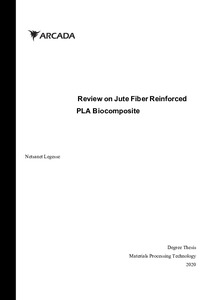Review on Jute Fiber Reinforced PLA Biocomposite
Legesse, Netsanet Tsegaye (2020)
Legesse, Netsanet Tsegaye
2020
All rights reserved. This publication is copyrighted. You may download, display and print it for Your own personal use. Commercial use is prohibited.
Julkaisun pysyvä osoite on
https://urn.fi/URN:NBN:fi:amk-2020052714283
https://urn.fi/URN:NBN:fi:amk-2020052714283
Tiivistelmä
The primary goal of this thesis was to gather scientific research data and review natural fiber reinforced biocomposites. Considerably, it analyzed the methodologies applied to produce biocomposites and presented the result. Plant fibers are composed of chemical substances called cellulose, hemicellulose, and lignin. However, cellulose is the main structural component of plant fibers used to reinforce biocomposites. Jute fiber is one of the most known plant fibers used to reinforce thermoplastics such as PLA. The reinforcement of jute fiber into the PLA matrix gives sustainable material called biocomposite. Biocomposites possess good mechanical properties, simultaneously they are renewable. However,to achieve good mechanical properties, performing surface treatment is crucial before reinforcing fibers into the matrix. Thus, alkali treatment is a common surface treatment method for plant fibers. In this method, NaOH is used to remove impurities from the surface of the plant cell wall. After alkali treatment, hydrophobicity and surface roughness increased on the plant surface wall, which increases fiber-matrix adhesion. Biocomposites can be produced using conventional compounding methods such as compression molding, injection molding, and extrusion. Besides, surface characterization of composites can be analyzed using DSC, FTIR, and SEM methods. Tensile test, flexural test, and impact test are the known mechanical testing methods in biocomposites. The tensile testing result shows, the tensile strength of biocomposite with treated jute fiber displayed higher tensile strength compared to untreated jute fiber. Rising in fiber loading increased the tensile strength of biocomposite. However, an increase in the concentration of NaOH reduced the flexural strength. SEM imaging of biocomposite displayed the presence of interconnected fibril networks in the biocomposite.
